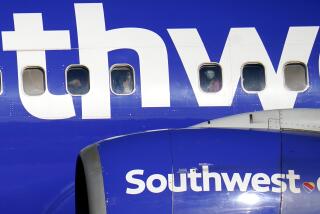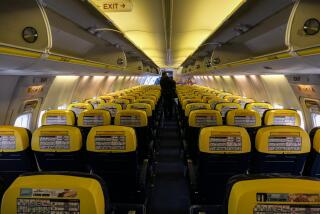Making Skies Friendlier for Kids Flying Alone : Airlines: Experience shows that parents don’t need to fret. But they should arrange for their children to fly nonstop if possible, and give precise instructions.
This summer, thousands of children will be flying solo. With the number of single-parent families increasing, as available evidence suggests, the number of children flying alone to see a separated parent has also zoomed. And then there are the children going to summer schools, camps or to visit other relatives.
Exact figures are hard to come by, but United Airlines estimates that this year it will carry more than 100,000 unaccompanied minors, or “UMs.” Continental predicts that it will fly more than 175,000 UMs this year.
UMs range in age from 5 to 12 years old. On some crowded flights, especially during the peak vacation periods during the summer and holidays, there can be as many as 20 or more UMs.
Does this make the airlines willing baby-sitters?
Hardly.
So if you’re planning to send your child alone on a flight this year, should you be worried?
Not necessarily.
There are a number of things parents can do to help their unaccompanied children get between point A and point B safely, and with a minimum of hassles.
Most important, parents can exercise some common sense to help ensure that their children aren’t treated as unidentified flying objects.
First, the industry rules:
--No airline will accept an unaccompanied child under the age of 5.
--Children between the ages of 5 and 7 will generally be accepted on nonstop flights.
--Children between the ages of 8 and 11 will generally be accepted on nonstop as well as connecting flights.
--UMs will be charged the published adult fare. And, with one exception, UMs making flight connections will be charged $25 per connection by the airline.
“The air fare is not a great deal,” says Dorothy Jordon, managing director of Travel With Your Children (TWYCH), a New York-based organization that also publishes a newsletter called Family Travel Times. “You would think that for the full fare, the kids would get extra attention. Not really. On connecting flights, they even charge to walk the child from one gate to another.” (The one exception among the major carriers: Delta Airlines, which charges no fee to escort UMs to connecting flights.)
Once on the plane, some airlines try to seat UMs together. And, on some flights, crews have been known to give the kids free headsets, serve them first and also provide extra snacks. But don’t count on this.
Some important cautions:
--Make sure that your child is nothing less than a walking Rolodex; give him/her cards with their name, home address, phone number, destination and appropriate phone numbers and names of the person/people meeting them when they arrive.
--Teach your child how to make a collect phone call. Some parents give their children things they can’t possibly use on a trip, such as credit cards. (What merchant is going to accept a Visa card from a 9-year-old?) Or they give their kids large bills that they might have difficulty cashing.
Instead, parents should give their children small bills as well as at least $2 in coins to use at pay phones if necessary.
--Try to book your child--if possible--on a nonstop flight. When getting a seat assignment, ask the airline to put your child as close to the front door as possible.
If you can’t book a nonstop flight, try not to book your child on a connecting flight that is the last plane of the day leaving that second airport.
--Once you put your child on the plane, don’t leave the airport. Stay at the terminal and make sure that not only has the plane left the gate, it has left the airport. “Believe me,” says Jordon, “I know how important this is.”
Not long ago, Jordon put her child on a flight. After the plane had pushed back from the gate, a mechanical problem was discovered. The plane returned and was delayed nearly five hours. “I was the only parent who stayed,” she reports. “My child was very happy to see me.”
For those waiting to meet UMs, some other important rules:
--Don’t assume that the airline staff will escort the child through the terminal. Meet the arriving flight at the gate. And bring proper identification to prove that you are the designated adult who is meeting the child.
One important caution: For parents sending an unaccompanied minor to Canada, Central or South America, you’ll need to supply a notarized letter of permission. Some countries require that letter from each parent.
“If you can,” says Jordon, “try to find out what makes your kid nervous--if anything--and deal with those fears. Kids sometimes don’t understand that you’re not going with them, and it often helps when you tell them this up front. It’s a really bad idea to try to withhold that information until you’re putting the child on the plane.”
--For older children, give them some gum or hard candy so that they can swallow often during landing to avoid a pressure build-up in their eardrums.
--Include a funny note inside one of their books that they can discover once on the plane.
--You can order a special meal for your child, but be warned: Children’s meals don’t always include hot dogs or hamburgers. (My suggestion: Try a fruit plate order instead.)
In any case, always give the child some extra fruit to bring along. “Or,” Jordon adds, “I give my kids one of those little boxes of fruit juice. Usually, children are too short to reach the stewardess call button, and, let’s face it, airline food never arrives when kids are hungry.”
Last but not least, Jordon advises that parents take some additional responsibility when their children are boarding the plane.
“I always try to walk my child onto the plane,” she says. “I like to be introduced to the stewardess or flight attendant responsible. Sometimes the airlines will let me do it, sometimes they won’t. It all depends on how busy the airline is or how full the flight. But I always try. It’s important for parents to communicate to the airline staff. That way, you’ve made contact with another human being and identified your child.”
That may not guarantee extra care on board, but it could help. Remember, there is no federal regulation requiring an airline to board extra flight personnel to handle UMs. During peak holiday traffic periods, this can make for some potentially wild airline flights.
Surprisingly, perhaps, the airborne UMs have flown with few reported incidents of trouble. And when there have been delays or flight cancellations at connecting airports, airline personnel have often taken the kids home for the night.
“In just the last three months,” says Delta spokeswoman Frances Conner, “our customer service agents in Boise, Salt Lake City, Dallas and Orlando have provided overnight accommodations in their own homes for children who were stuck at airports because of weather or flight cancellations or missed connections.”
Recently, a brother and sister traveling between Florida and New York on USAir got stuck while making a connection in Baltimore. Weather conditions canceled their flight.
Service agent representative Joyce Brown called the children’s parents and explained the situation. Then, she took the two kids to a nearby hotel, arranged for adjoining rooms, got them dinner and spent the night with them.
“The kids thought it was a great adventure,” Brown reports, “and the parents were relieved to know their kids were all right.”
Any drawbacks? “Just one,” Brown admits. “I ended up watching a lot of cartoons.”
“It’s amazing how quickly most kids adapt to their environment,” says TWA flight attendant Lenore Kadish. “In fact, in my experience, I’ve never had an unaccompanied minor misbehave on a flight. If anything, they’re very polite and extremely quiet.
“The ones we worry about are the unaccompanied adults. If you want to hear some real whining, try a 40-minute delay on a frequent flier businessman and you’ll see someone turn into a screaming child.”
The U.S. Department of Transportation publishes a special “Kids and Teens in Flight” booklet. It’s available, free of charge, by writing the U.S. Department of Transportation, Consumer Affairs, 400 7th Street S.W., Washington, D.C. 20590.
TWYCH also publishes a special airline guide for families traveling with children. It’s available for $10 by writing TWYCH, 80 8th Ave., New York 10011.
More to Read
Sign up for The Wild
We’ll help you find the best places to hike, bike and run, as well as the perfect silent spots for meditation and yoga.
You may occasionally receive promotional content from the Los Angeles Times.





